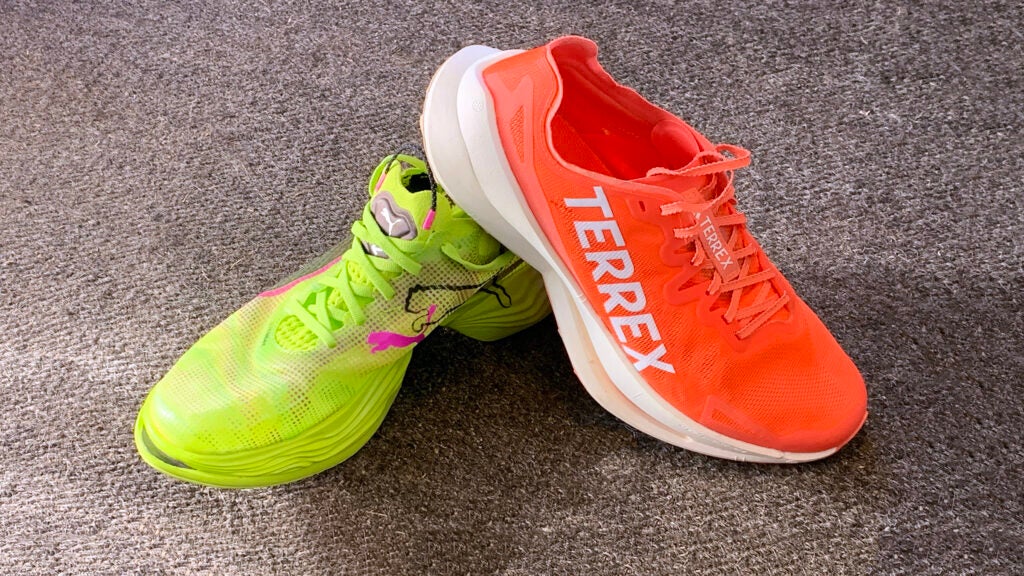No products in the cart.
Outdoor Adventure
The Running Shoes We’re Most Excited to Try in 2024
With the new year approaching, running shoe brands have started previewing the models they’ll roll out out in 2024. The new crop shows lots of promise, with advanced materials and innovative designs delivering versatile shoes that are smoother-riding, faster, more comfortable, and more durable than ever. Here are some of the models that we’re most excited about running in when they’re available in the coming months.
Topo Specter 2 ($165)
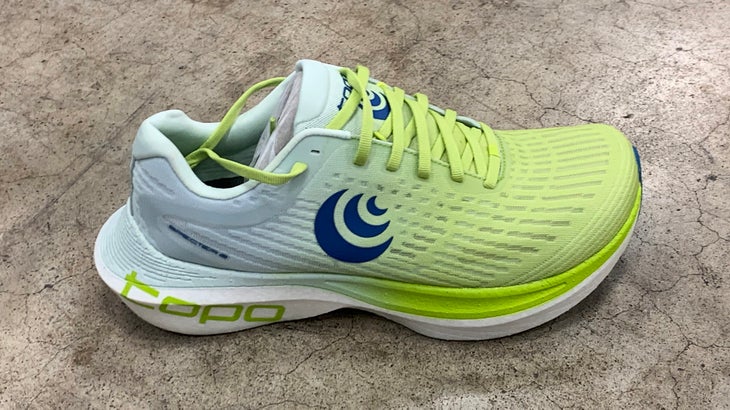
Slated for May 2024
I was leery when Topo—a brand that started out making second-generation, slightly more cushioned minimalist models—launched the high-stack, well-cushioned Specter in 2022. But the shoe won me over because it maintained the stable ground feel I expect from the brand while delivering bouncy, lively cushioning. Topo achieved this by encasing a Pebax footbed in a firmer EVA frame that kept the foot rolling forward, not sideways. Even I admitted, however, that the frame sacrificed some of the exciting boing delivered by full-Pebax midsoles.
Last year, Topo delivered a full-Pebax shoe, the Cyclone 2, which avoided squishiness and instability by having a lower stack height and wide platform underfoot. I fell instantly in love, and it is now my favorite Topo—one of my favorite running shoes ever, in fact.
Now Topo has announced a new Specter, which will also have a full Pebax midsole, but maintains its high stack height. It even gains two millimeters, making it a whopping 37 millimeters in the heel, 32 in the forefoot—nine millimeters higher than the Cyclone 2. Despite the thick stack of soft, bouncy foam (the same density as in the Cyclone 2), and the lack of a plate to control that foam, Russ Stevens, product manager at Topo, says I won’t be wobbling or wallowing in them due to their geometry. “The heel is quite wide and you’re almost sitting down inside the midsole platform,” Stevens says. “So when you’re landing, you’re not rocking side to side—you roll nicely through the gait cycle. It does a great job of feeling light and responsive while still providing that stability.”
While I’ll have to experience it to believe it, I have been impressed with other recent models that create stability through geometry. I also prefer not to have a rigid plate in a training shoe because of injury risk and loss of foot strength. Stevens added another good reason why they went plateless: “We wanted to make sure that this shoe stayed fast, light, and responsive regardless of pace. By putting a plate in the shoe, we were concerned that we had to dictate the pace that the shoe was best at, because you have to tune the plate to an ideal runner. By keeping the plate out of it, it made the shoe more democratic.” Plus, omitting the plate saves some weight—the shoe comes in at only 7.6 ounces.
Even a cushion-leery curmudgeon like me can’t help getting excited about the promise of a shoe with Topo’s fit—snug from heel to arch with plenty of toe room—and the bounce of a full stack of super foam that stays in control through clever geometry. I’m eager to run in the new Spectrum to see if they pulled it off.
New Balance Fresh Foam X Balos ($200)
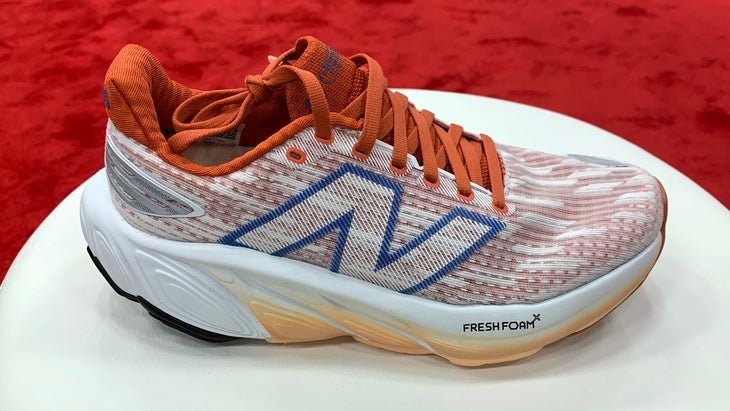
Slated for August 2024
Early Fresh Foam shoes from New Balance like the circa-2015 Zante were responsive, nimble, and rather firm, as befitted fast shoes of the day. I recall many pleasant up-tempo training miles in them. Through the years, the line has lost its speedy heritage and morphed into super-soft models that the brand admits are made more for wearing 24/7 than for logging serious miles. This shoe is a return to high-performance training, executed in a new way in this age of super foams. “What we wanted to do was to bring a super trainer into Fresh Foam,” says Constanza Campos, global product manager for performance running at New Balance.
What makes the Balos stand out is the Peba-based foam (the first use of the industry-leading midsole material in the Fresh Foam line), and the shoe’s unique geometry. The forefoot is aggressively rockered, like most fast models today. The Balos goes one step further with significant heel camber as well, which, combined with the malleable Peba foam and the gound-contact EVA outsole (remember the Beacon?), promises super-smooth landings and a seamless, fast-rolling ride from touchdown to toe-off. Like the Topo Specter, the Balos won’t have a prescriptive plate, allowing for each runner’s preferred movement pattern during training miles. High sidewalls and a wide base should keep the foot centered on the platform as you compress and rebound off the sole.
Rounding out the package is a comfy and secure upper. “Our inspiration was to create a crossover between racing and training,” Campos says. “So we wanted the lightweight, the breathability, the technicality of a racing shoe, but with the comfort of a training shoe.” Centering the fit is a stretchy, gusseted knit tongue that Campos calls, “Crazy nice.”
It’s easy to imagine putting in comfortable long miles and bouncy tempo runs in this 9.2-ounce trainer when it comes out in August.
Puma Fast-R Nitro Elite 2
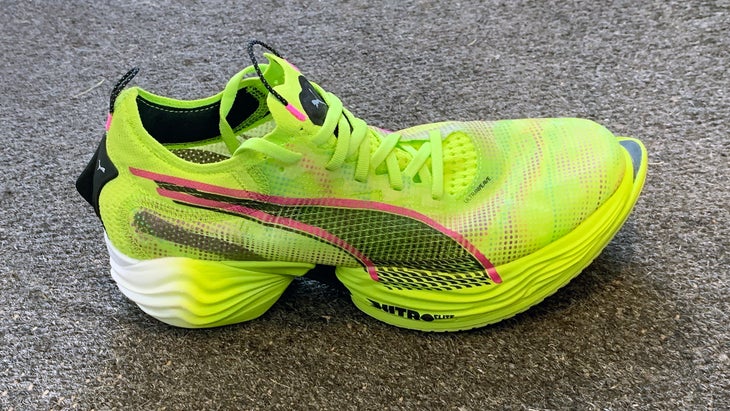
Slated for February 2024
Two years ago, I named the first Puma Fast-R Nitro Elite as one of the shoes I was most excited to try in 2022 because of its decoupled sole, which allowed the heel and toe to move independently (and made it look über-cool). That shoe did indeed deliver a unique ride, but the different midsole compounds—Pebax in the forefoot, EVA in the heel—made the decoupling feel somewhat disjointed. This second version has the same foam under both ends, promising to smooth out the ride, plus Puma introduced new materials and innovations that have me salivating to try this one on the roads as well.
The second version of the Fast-R got upgrades in both elements that define super shoes: the foam and the plate. Todd Falker, the brand’s head product line manager, says they went to the lab and asked, “For the last seven years, everyone has said Pebax is the best thing in the industry. What is the next best thing?” And the materials lab had an answer: Aliphatic TPU, a polymer, which, in membrane form is often used in aviation for its lightweight durability. As Falker describes it, this new compound retains all the bounciness of TPU in a lighter, more consistent foam, with more energy return than Pebax (they measured the Aliphatic TPU at 93 percent). Plus, it has endurance. “It is as strong at mile 25 as at mile one, or through a few hundred miles,” Falker says. “You get consistency in performance; the foam doesn’t degrade like others do.” The Aliphatic TPU delivers a similar squish-and-rebound trampoline effect as Pebax, but Falker says it feels a bit firmer underfoot, more bounce than squish, which I personally appreciate.
The Fast-R 2’s new plate is unique because it extends past the toe, sticking out from the midsole like the tip of an impertinent tongue. Falker says the patented design will add length to each step. “Our researchers have shown that it saves about 50 steps over the course of a marathon,” he said. Whether or not that will hold true for every runner, it will be intriguing to experience what Falker claims is the “longest and most aggressive plate in the industry.”
The next best thing in foam, coupled with a step-saving plate—what’s not to get excited about? I’ll use them sparingly but will certainly be trying them out when they’re available at retail in February.
Mount to Coast R1 Racer ($180)
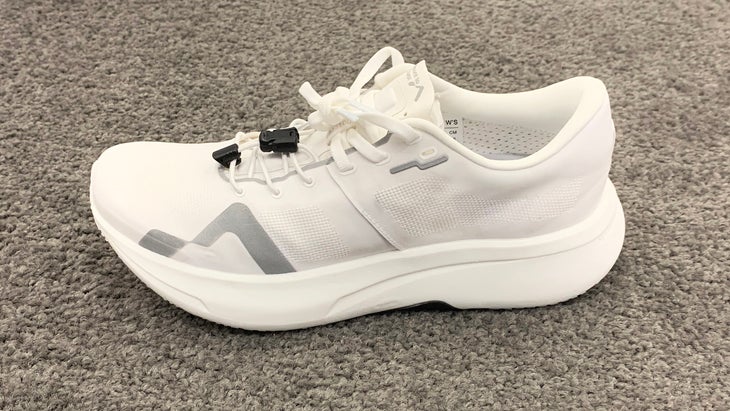
Slated for April 2024
Every year we see several new brands try to break into the crowded running space. One that caught my eye this year was this clean-looking model designed for racing ultramarathons on the track. The oddly-named Hong Kong-based brand says their designs are rooted in a biomechanics lab where they can optimize the shoes’ ergonomic fit and long-run comfort and support. I don’t have a track ultra on my schedule any time soon, but I am interested in trying this shoe for several reasons.
First is the plateless, moderate-height (28/22mm) Pebax midsole with a PU insert under the highest-pressure areas that, combined, promises a smooth, bouncy ride with staying power. “They are made of very durable materials,” says Victor Zhang, head of sourcing at Mount To Coast. “They may last over 1,000 miles.” That’s an impressive claim, but they’ve got the ultrarunner testing to prove it.
Second, I love the decoupled closure system, with traditional laces on the top half of the eyelets, and a separate quick-pull lace on the bottom. I’ve long felt that it makes sense to be able to tighten these parts of the shoe separately, as the tension needs on the instep—where you want to lock the fit down—and ball—where you need room for splay—differ at all times, and even more so when the foot swells as you’re going long. This design makes it easy to dial in the different zones, and to quickly adjust the lower half tension when needed.
I also got to step into a pair of the R1s at The Running Event in late November, and can attest to the comfort of the shoe’s ergonomic fit: both the upper and the sole matched my foot shape, holding and supporting invisibly. A few running steps revealed a lightly cushioned, firmly responsive ride (reminiscent of the Tracksmith Eliot Runner, but with a better fit), that made me want to head out the door in them. I’ll have to wait for the April 18 release date before I can see if they live up to their promise on the long run.
Adidas Terrex Agravic Speed Ultra ($220)
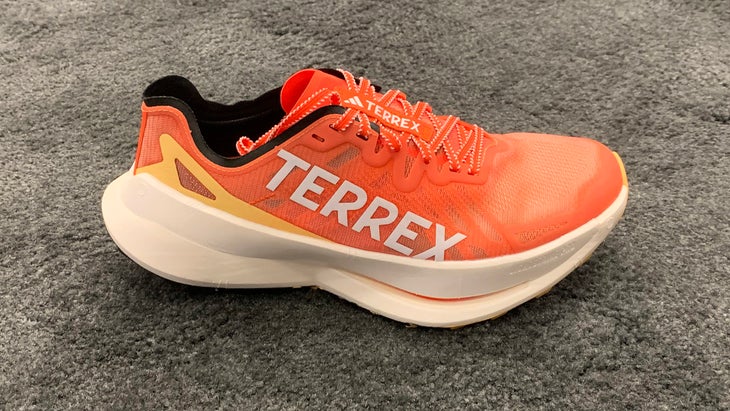
Slated for April 2024
Lots of people have been eager to try this shoe, ever since Tom Evans wore a prototype to victory at the 2023 Western States 100. After having a chance to see and feel a production model, I’m even more excited about taking them out on my trails and dirt roads.
What impressed me most about the shoe is that it appears to be designed to act as an extension of the foot, rather than as a platform to land on and roll off of, like many max-cushioned models. The shoe’s shape is foot-like from heel to toe: the heel is rounded where you roll onto it, and relatively narrow, avoiding the rotational torque from the long levers created by flared soles—while your foot sits inside high sidewalls to ensure you stay centered. The shoe’s midfoot is even narrower and can flex rotationally, letting the rear- and forefoot act independently as you encounter uneven footing. The forefoot, however, widens out dramatically—like the human foot—enabling a stable, engaged stance.

Inside the midsole, the “plate” is actually four rods that act independently—like foot bones—and are made of Pebax in its firm plastic mode as you’d find in sprint spike plates. These rods splay closer to the outside edges of the forefoot than the ones on Adidas’s road models, providing more stability. They are also semi-flexible and responsive, to allow adaptation to technical terrain and add to the pop of the push-off.
The midsole itself is a thick (38–30mm) stack of Lightstrike Pro, a Peba-based foam used in Adidas’s top-end Adizero marathon racing models. Based on my experience with those shoes, I believe the foam will translate well to the trail, as it provides plenty of bounce but not as much squish as other super foams, delivering more of a smooth, highly responsive roll than a soft trampoline—so it won’t be bouncing you sideways on a trail.
Given their stack height, I probably won’t use them for truly gnarly terrain, where I’m much more comfortable being close to the trail (see the Brooks Catamount Agil), but I can’t wait to take them on long tempo runs on moderate trails when they’re available after April 15.
Brooks Catamount Agil ($180)
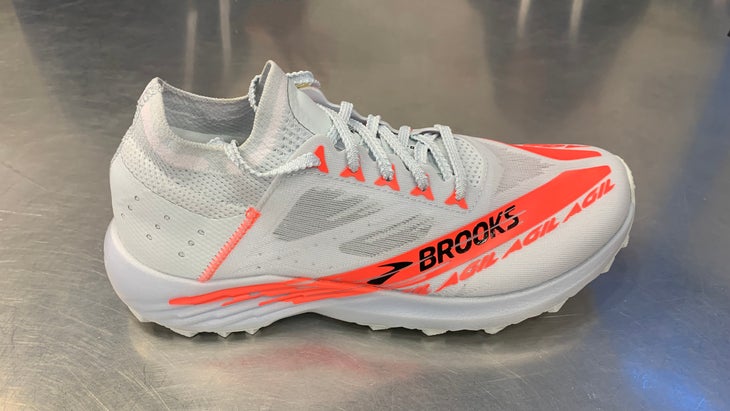
Slated for January 2024
Many runners seem to be fine running trails on high-stack shoes, as evidenced by the proliferation of max-cushioned trail models on the market today. I’m not one of them (which probably stems from having broken a bone in my foot when I rolled it over on a root while wearing a tall, squishy trail shoe). As a former (and sometimes current) minimalist, I’ve reluctantly learned to appreciate more cushioning and rebound on roads and smooth trails, but when I’m navigating rocky and rooty terrain I want to feel the trail and be able to react quickly and agilely. So I’m pleased when a company introduces a shoe that is svelte and nimble.
The original Brooks Catamount training shoe already had a moderate stack height (31–25mm) and a flexible, articulated plate that gave it a stable feel and a lively ride. But, the brand says, Brooks’ athletes asked if they could get a lighter, more flexible shoe to race in. Ask and ye shall receive: meet the Catamount Agil.
The new model keeps you closer to the ground while promising to still provide a lively underfoot feel by using a thin (26–18mm) layer of Brook’s most responsive foam, DNA Flash V2, a nitrogen-infused EVA-TPU blend found in their marathon-racing super shoes. The Agil has a new split, articulated, flexible Pebax plate that adds pop without losing proprioception, and gains deeper lugs for sure-footed foot-plants when moving fast and changing directions—but weighs in nearly two ounces lighter than the Catamount.
I love the Catamount (it will stay around, getting an updated upper for version 3 in 2024) and plan to keep wearing it for daily miles on long trail runs. But I’m itching to dance across rocky ridges, descend gnarly switchbacks, and bounce up boulder-strewn ascents in the Catamount Agil when it comes out in January.
Source link

